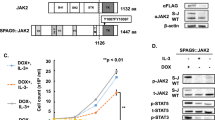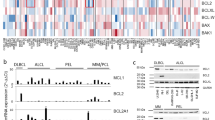Abstract
Fas (APO-1/CD95) is a cell-surface protein that can mediate apoptosis upon specific ligand or antibody binding. The Bcl-2 protein may function as a modulator of Fas-induced apoptosis by blocking a downstream activation step, and Bcl-2 expression in acute lymphoblastic leukemia (ALL) cells appears to depend partly on expression of a wild-type (wt) p53 tumor suppressor gene (Findley et al, Blood 1997; 89: 2986). We therefore investigated the relationship between sensitivity to Fas-mediated apoptosis and (1) Fas expression, (2) p53 status, and (3) Bcl-2 protein levels in pediatric ALL cell lines and primary leukemic cells. Cell lines included 21 B cell precursor (BCP)-ALL and four T-ALL lines; in five cases, cryopreserved primary leukemic cells from which these lines were established were also examined. Additionally, we evaluated the effect of anti-Fas monoclonal antibody on the activation of protease CPP32 and induction of apoptosis in these lines. By SSCP analysis and DNA sequencing, we detected p53 mutations (mt) in eight out of 25 ALL cell lines (exon-7, codon 248 n = 6; exon-8, codon 273, n = 2). The expression of Fas and Bcl-2 was examined by immunofluorescence staining and quantified as the number of molecules of equivalent soluble fluorochrome (MESF). Elevated levels of Fas were expressed in all six lines with a mutation of p53 in codon 248 (1500 to 10 800 MESF). Although Fas was detectable in seven of the 17 lines with wt-p53, expression was lower (150–900 MESF) compared with mt-p53+ lines. Bcl-2 was expressed in 10 of the 25 lines. Most (9/10) wt-p53+ lines expressed Bcl-2, whereas only one of eight mt-p53+ lines and no p53-null lines expressed this protein. Treatment of Fas-positive lines with anti-Fas monoclonal antibody (200 ng/ml) for 6 h induced activation of CPP32 and apoptosis in eight of 13 Fas+ lines. Sensitivity to Fas-mediated apoptosis was associated with a mt-p53 phenotype and absence of Bcl-2 expression. Six of eight Fas+/Fas-sensitive (S) lines were mt-53+/Bcl-2−, whereas only two Fas+/Fas-S lines were wt-p53+/Bcl-2+; both of these latter lines expressed low levels of Bcl-2 compared to Fas-resistant lines. In contrast, four of five Fas+/Fas-resistant (R) lines were wt-p53+/Bcl-2+; the exception was p53-null/Bcl-2− but expressed a low level of Fas (150 MESF). Activation of the cysteine protease CPP32 and cleavage of its substrate poly(ADP-ribose)polymerase (PARP) was also detected in Fas-S but not Fas-R lines. We obtained similar results from both the primary leukemic cells and the corresponding cell lines in five cases: overexpression of Fas and Fas-sensitivity were present in mt-p53+/Bcl-2− but not wt-p53+/Bcl-2+ cells. These results suggest that some pediatric ALL cells expressing mt-p53+ may be sensitive to Fas-mediated apoptosis due to high levels of Fas expression and lack of Bcl-2, and further suggest that molecular methods of activating Fas may be useful for therapy of refractory ALL with the Fas+/mt-p53+ phenotype.
This is a preview of subscription content, access via your institution
Access options
Subscribe to this journal
Receive 12 print issues and online access
$259.00 per year
only $21.58 per issue
Buy this article
- Purchase on Springer Link
- Instant access to full article PDF
Prices may be subject to local taxes which are calculated during checkout
Similar content being viewed by others

Author information
Authors and Affiliations
Rights and permissions
About this article
Cite this article
Zhou, M., Gu, L., Yeager, A. et al. Sensitivity to Fas-mediated apoptosis in pediatric acute lymphoblastic leukemia is associated with a mutant p53 phenotype and absence of Bcl-2 expression. Leukemia 12, 1756–1763 (1998). https://doi.org/10.1038/sj.leu.2401198
Received:
Accepted:
Published:
Issue Date:
DOI: https://doi.org/10.1038/sj.leu.2401198
Keywords
This article is cited by
-
The traditional Chinese medical compound Rocaglamide protects nonmalignant primary cells from DNA damage-induced toxicity by inhibition of p53 expression
Cell Death & Disease (2014)
-
p53-dependent Fas expression is critical for Ginsenoside Rh2 triggered caspase-8 activation in HeLa cells
Protein & Cell (2014)
-
Targeting survivin and p53 in pediatric acute lymphoblastic leukemia
Leukemia (2012)
-
Effect of C-terminal deletion of P53 on heat induced CD95 expression and apoptosis in a rat histiocytoma
Oncogene (2002)
-
The kiss of death: promises and failures of death receptors and ligands in cancer therapy
Leukemia (2001)


